Flower plants that Grow and Bloom in the shade

This post is also available in:
This post is also available in:
![]() Français (French)
Français (French) ![]() हिन्दी (Hindi)
हिन्दी (Hindi) ![]() Ελληνικά (Greek)
Ελληνικά (Greek)
Find out the best plants to give color to the darkest places of your garden.
Most plants flourish under the beneficial effect of ample sunlight and fill the open spaces of gardens and parks with vivid colors. However, tall trees and buildings shadow most of the area of modern, small city gardens and balconies. Thus, plant enthusiasts are looking for flowering plants capable of growing and blooming in such conditions. There are shade-loving plants that are more adaptive to different types of shade:
Light shade? slight shade for most/all of the day
Partial shade? direct sun exposure for a certain period (3-6 hours) during the day
Dappled shade? the sunlight is “filtered” through other plants’ foliage
Deep/Full shade? shade caused by the dense foliage of evergreens or buildings. The plants may receive up to 3 hours of direct light during the day.
To enjoy your flowering plants for longer, consider the planting zone you are into when choosing them. These zones reflect, among others, the minimum winter temperature and, as a result, the chance of your plant surviving through winter. There are 13 planting zones, each covering a 10-degree Fahrenheit range. More specifically, zone 1 is the coldest (-60 to -50 °F or -51 to -45 °C), while zone 13 is the warmest (60-70 °F or 15-21 °C). If you know exactly which planting/hardiness zone you are in, you can choose plants that cope well with the local environmental conditions.
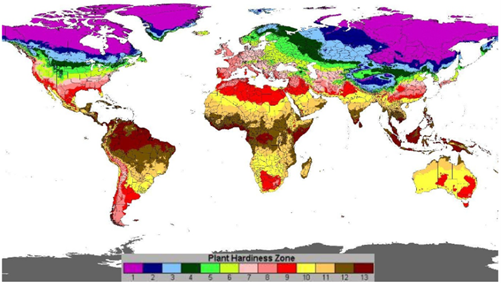
Global plant hardiness/planting zones (de la Peña et al., 2019)
Perennial flowering plants to grow in the shade
 Deep shade
Deep shade
Hardy geraniums
Many species of hardy geraniums can survive and bloom in partial or even deep shade, below other taller shrubs, trees, or/and the shadow of buildings. More specifically, Geranium nodosum and G. phaeum (Lily Lovell) are ideal for growing in fully shaded places. Depending on the variety, these geraniums can be planted and survive through winter in areas of zones 4 to 8. The plants tolerate dry shade and prefer moderately fertile, well-drained soil with a mildly acidic to neutral pH (6.1-7.5). The flowers are small in size and have a trumpet shape and a violet/lilac-pink color, while the foliage is dark green and glossy. Due to the small final size of the plants (6-12 inches or 15-30 cm tall and with up to 12-16 inches or 30-40 cm spread), we can place 8-10 pieces per square meter (30-35 cm or 12-14 in. distance). Blooming takes place from spring to fall.
Campanula Bellflowers
The Campanula group includes hundreds of plants (perennials, biennials, and annuals) that flower during summer and early autumn. Bellflowers may grow successfully in zones 3 and 4 and partially in deep shade. A good candidate for the darker corners of your garden is the species Campanula persicifolia (or C. amabilis/C. subpyrenaica). These plants form rosettes (70 cm or 28 inches in height and 1 ft or 30 cm spread) with narrow, evergreen basal leaves of bright color, stiff stems, and bell or cup-shaped flowers from blue to white shades. Campanulas prefer fertile, moist, well-drained soils with neutral to alkalic pH.
Digitalis (Foxglove) Digitalis grandiflora and D. purpurea
Both species number dozens of commercial varieties that can successfully withstand light to full shade and grow in planting zones 3-8. These biennial plants tolerate almost any soil but perform best in rich, moist soils. Waterlogged or excessively dry conditions should be avoided. More specifically, when the plants are grown in warm conditions, more protection from the sun and water is required. Depending on the variety, the plants can grow a rosette during the first year and produce a stem up to 1-2 m high during the second year. The beautiful Foxglove flowers can be observed during the second year and are bell-shaped with colors that range from white to pink and purple. Finally, except for the dense and beautiful flower spikes, most amateur growers choose Foxglove also due to the little care it needs during their life cycle. Moreover, thanks to the seeds spread by the parent plants, you do not have to resow (or replant) Digitalis.
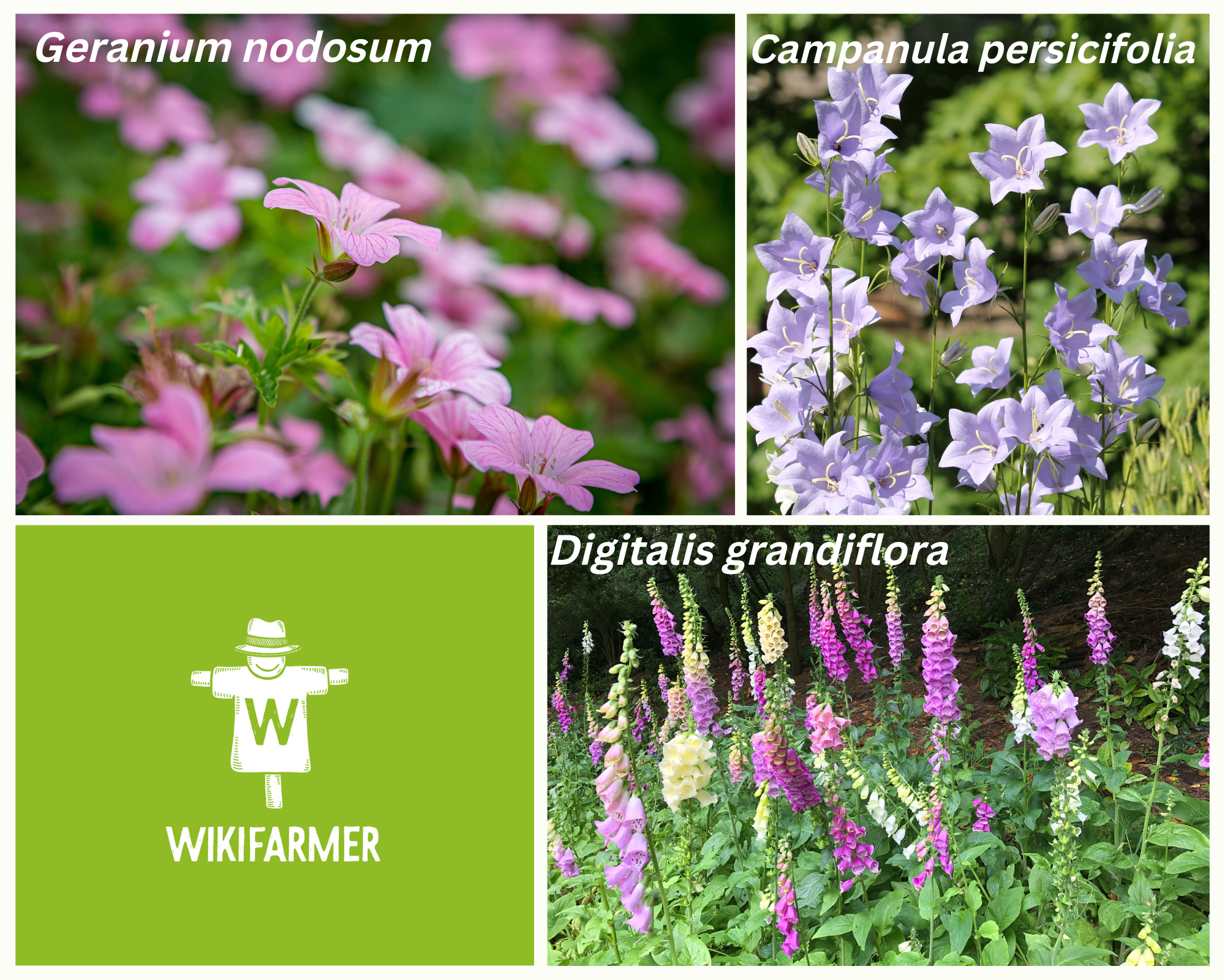
Perennial flowering plants to grow in deep shade
 Partial and dappled shade
Partial and dappled shade
Primrose (Primula vulgaris) and Cowslip (Primula veris)
Due to the significant genetic variability of these short-lived flowering perennials, with more than 400 species, you can easily find the variety that fits your standard and needs (zones 3-9). The plants bloom from the center of the leaf rosette, from early spring through summer, and can fill your garden with beautiful small flowers (white, yellow, blue, orange) and pleasant aromas (P. veris). The early and rich bloom attracts pollinators like bees and other beneficial insects. These plants grow well in moist soils, under partial and dappled shade, and in garden beds and containers. The type of soil is never a limiting factor for their growth. Depending on the variety, primrose can grow 6-20 inches or 15-50 cm tall and a spread of 8 to 20 inches or 20-50 cm. We can use an all-purpose or natural fertilizer (e.g., compost) to boost their growth. Many plant lovers choose to grow Primula alongside Narcissus, Viola, and Anemone.
Astilbe (Astilbe chinensis)
Astilbe is a shade-loving plant with one of the most spectacular flowering (mid-summer). These clump-forming perennials produce tall pyramidal plums (feathery-looking flowers that each caries hundreds of tiny flowers) of bright pink-red color that are also used as cut flowers (fresh or dried in bouquets). The plants thrive in zones 3-8. Fertile, moist, but well-drained loamy soils are preferred. Astilbe is fast-growing and can become 18 inches or even 5 feet (46-150cm) tall, depending on the variety. Although the plants are relatively drought tolerant (when mature) and demand little maintenance, it is best to supply them with sufficient water throughout the growing season, especially when they are more exposed to sunlight.
Other beautiful and resistant flowering plants that can thrive in partial and dappled shade are the: Clematis (climbing plant), Bleeding-heart or Dicentra (Grows in zones 3 to 9, flowers in early spring), and Foam Flower (growth in zones 4 to 9, flowers in spring to early summer)
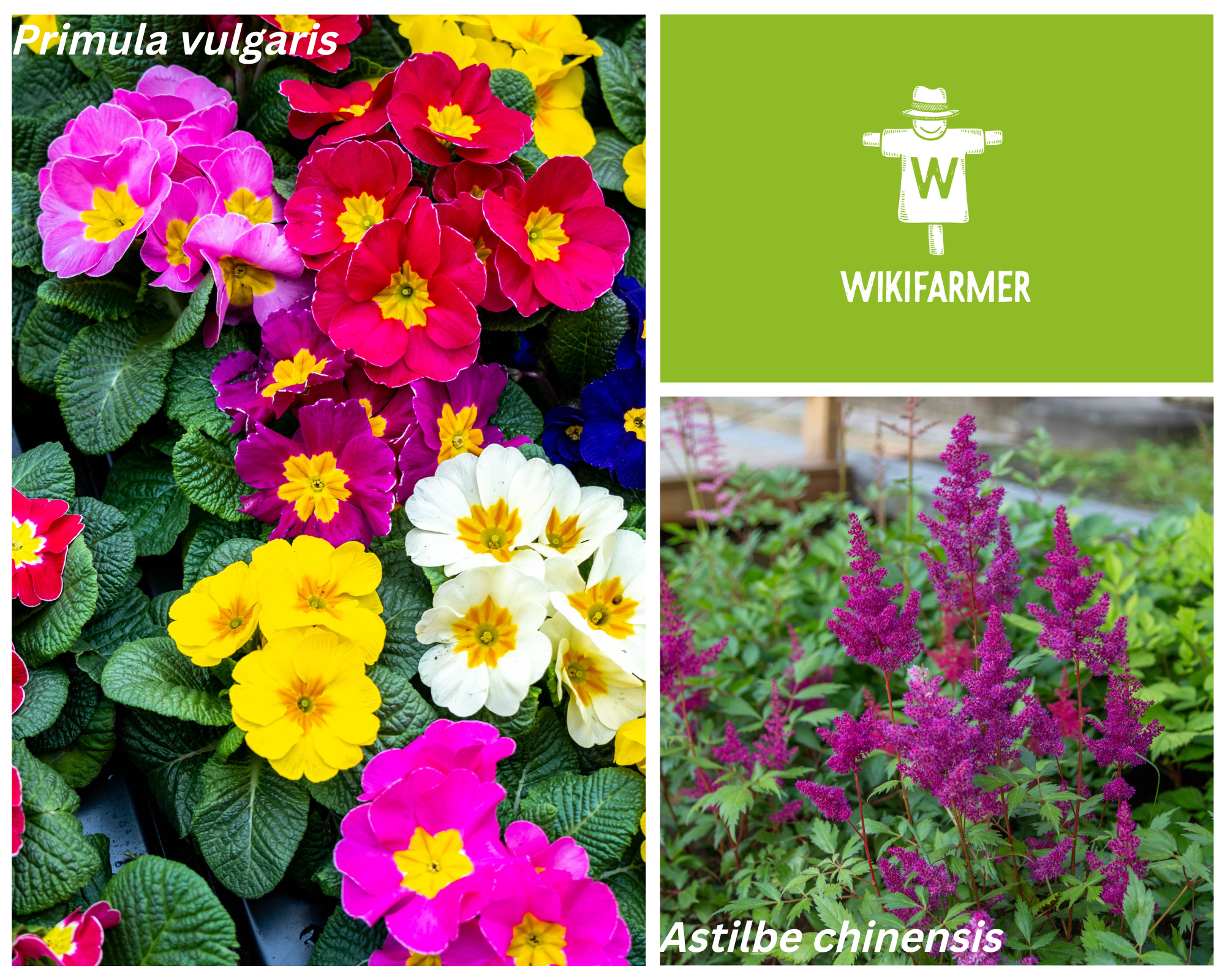
Perennial flowering plants for dappled and partial shade
 Light and Partial shade (3-6 hours of sunlight)
Light and Partial shade (3-6 hours of sunlight)
This level of shade has only a limited negative effect on the growth of the plants. As a result, many different species can be included in this category, like violet, pansy, calendula, hydrangea, snapdragons, star jasmine, grecian windflower, hakonechloa, heavenly bamboo, scarlet firethorn, bugleweed, camellia, rhododendron (alpenrose), nerium, ligularia, wishbone, etc. Bulb flowering plants like tulips, anemones, cyclamen and narcissus are also tolerant to part shade and can also be used.
Hydrangea (Shrub)
Hydrangeas are an all-time classic preference of many plant enthusiasts due to their large, rounded cluster of blue, pink, and white flowers that gives color to light-shaded, north-facing areas of gardens and balconies throughout summer and fall (zone 3 to 9). An exciting feature is that the flowers become blue in acidic soils and pink in more alkalic ones. While hydrangeas can grow in various soils, they prefer fertile, moist, well-drained soils. To assist their growth, we should water at least once a week (1 inch of water), especially in dry, hot conditions, and add compost or appropriate hydrangeas fertilizers 1-2 times annually (spring, summer). Finally, depending on the variety, the plants must be pruned.
Camellia (C. sasanqua) (Shrub)
In gardens and pots, camellias are one of the loveliest fall flowers. The flowers are elegant, look like gardenias, and depending on the variety, they can be white, pink, or fuchsia-red. Camellias are more commonly grown in temperate climates (zones 6-9) and thrive in rich, slightly acidic, moist, but well-drained soils. Watering and soil moisture is most needed in the early stages and until plants’ establishment. As far as fertilization is concerned, you can choose a specialized fertilizer for camellias or flowering shrubs and apply it in late winter or early spring. Well-rotted manure, compost, or mulch also positively affect plants’ growth and preserve soil moisture. Finally, you are advised to prune your camellias in late fall or winter (after flowering). The severity and type of pruning needed depend on the plants’ general health, age, and appearance. Tip pruning generally encourages new, lateral growth, while you can shape your plants by applying harder pruning.
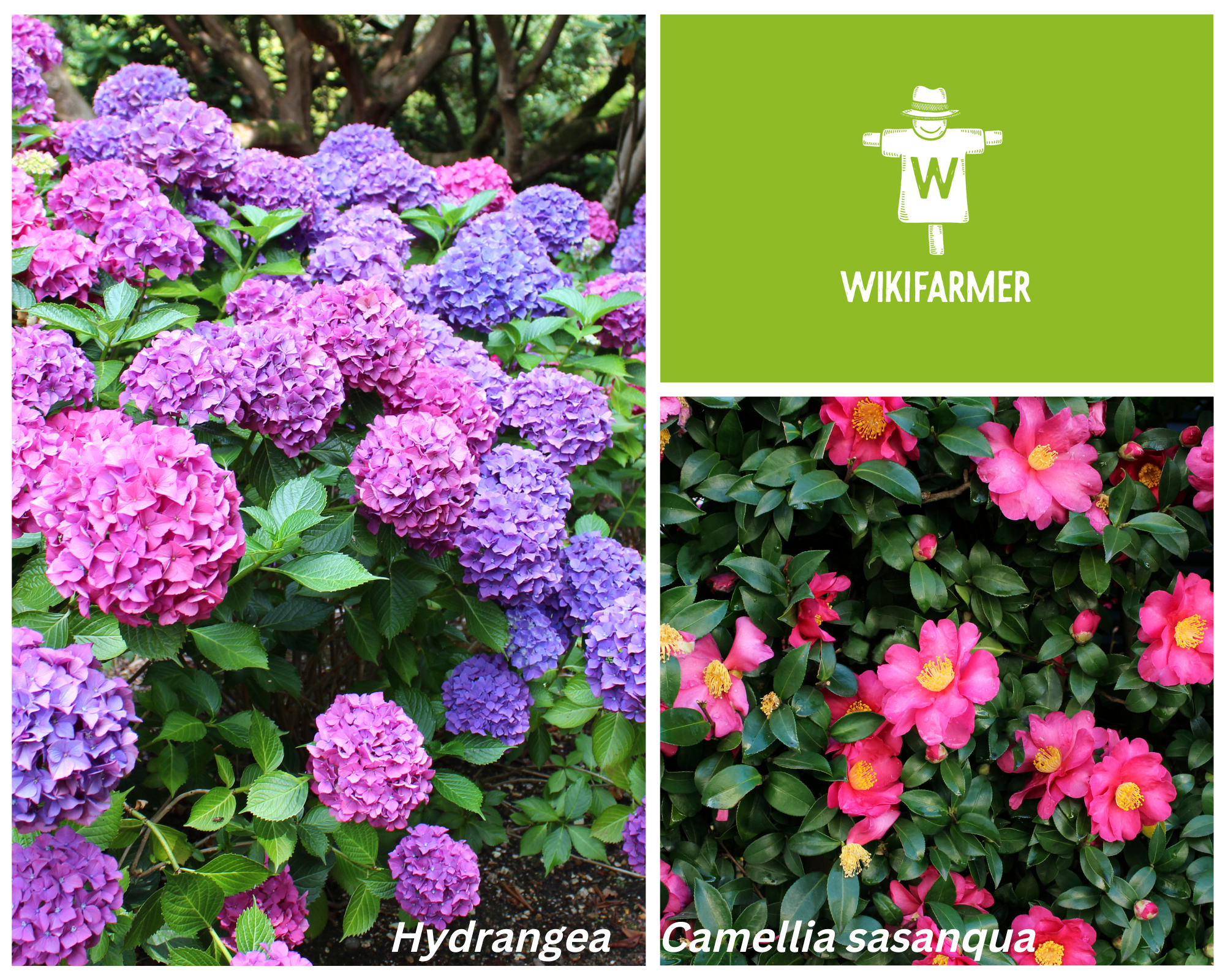
Perennial flowering plants for partial and light shade
Annual flowering plants to grow in the shade
The annuals (or annual-treated plants) have a special place in the house and public gardens. Gardeners and amateur growers choose these plants to add some color to the scenery as the season’s change or to fill empty spaces left by the shadow of larger (taller) perennial plants or buildings (partial shade).
Remember that depending on your planting zone, you may need to treat some well-known perennials (like begonia and hydrangea) as annuals due to the low temperatures recorded during winter.
Which are the best annual plants to grow in partial shade with minimum care
Common Impatiens (busy Lizzy) and New Guinea impatiens (Impatiens walleriana and I. hawkeri)
Impatiens is one of the most widely grown ornamentals globally, with new varieties and hybrids constantly being introduced in the market. Its beautiful flowers of various colors and the hardiness to grow in shady places are some of the most important reasons behind its success. Even in the most adverse conditions, this annual can thrive and usually outcompetes other (native) species, making it an invasive plant in many countries. You can plant it in garden beds or containers, and usually in groups to have dense and colorful banks- clusters. To find the most appropriate planting distances, consider that impatiens grow 1-3 feet or 30-90 cm (tall and wide). While it is more adapted in the climatic conditions of zones 10-11, where it grows as perennial, Impatiens can be planted in a bit colder regions as well (zone 9) and treated as annual. For better results, you can plant impatiens into slightly acidic, well-draining soils with sufficient moisture and organic matter, from sea level to 3,000 m altitude. In the cultivation zones, it can be sown in early spring when the temperature is close to 70-75 °F (20-24 °C) or planted as mature plants at the mid/end of spring. As the plant grows, we will need to irrigate to cover its water needs (800-2,500 mm annually). To boost the blooming of our plants, we can use a slow-release fertilizer twice a year (beginning of spring and mid-summer) or a water-soluble fertilizer every couple of weeks from spring through summer. To have many flowers, you are advised to avoid overwatering (or drought), overfertilization, and too much exposure of the plants to the sun. In gardens where downy mildew (phytopathogenic fungus) is a problem, you are advised to use the more resistant species, like I. hawkeri.
Tuberous begonias (Begonia × tuberhybrida voss)
Begonia numbers hundreds of species, and thanks to their large flowers’ various and vivid colors (whitish, orange, pink, red, salmon), they have become one of the most popular flowers to cover partially and dappled shaded places in zones 2-9. While Begonias, by nature, are perennials, in warmer climates (zones 10-11), in most areas are grown strictly as annuals. The plants can grow in garden beds or planters and hanging baskets. Despite their beauty, begonias are quite demanding plants making their care a bit challenging for amateur gardeners with limited experience. Most varieties need cool weather and humid summers in order to grow. These plants welcome partial shade from a neighbor plant, especially in warm regions. To grow successfully and have a rich bloom, begonias need loose, well-drained, and fertile soils with a pH of 6-7. You can often irrigate to keep the soil evenly moist, especially during the flowering period. However, you need to be careful not to overwater because the tubers may rot. Fertilization with all-purpose, slow-released fertilizers or compost should be performed every 4-7 weeks. Wax begonias generally require less care. In optimum conditions, the plants will bloom 4-5 months after planting (tuber) and can become 3 to 18 inches (7.6-45 cm) tall and wide, with flowers larger than 2 to 4 inches (5-10 cm) depending on the variety.
Browallia (B. americana and B. viscosa)
Browallia species have earned their place in most home gardens worldwide. While these plants are adapted and can survive from planting zones 3 to 10, they will produce more flowers (violet-blue color) through the season in warmer areas. Whether it grows in garden beds, planter, or hanging baskets, browallia can thrive in sunny and partly shaded places with minimum care and when the temperature remains above 40 °F (4-5 °C). The plant grows best in rich, evenly moist, and well-draining soils and can reach 8 inches to 2 feet (20-60 cm) in height and 14-16 inches (35-40 cm) wide. We can propagate browallia by seed or by mature plants. In any case, some typical planting distances are 6-18 inches or 15-45 cm. If we wish to have a more bushy appearance, we can pinch the tips of the stems. Since the plants are not drought tolerant, you have to keep the soil moist through the year with frequent irrigation (every 3 days) during summer. Moreover, an all-purpose water soluble fertilizer with a limited amount of nitrogen can be used once every 2-3 weeks from the end of spring to early autumn. Despite all its advantages, we would not suggest its cultivation in areas where cats and dogs play since it is toxic when digested.
Lobelia
In contrast to the tropical and warm-climate annual species mentioned above, lobelia thrives in cooler conditions. Some commonly used varieties are the L. cardinalis, L. erinus, L. puberula, L. siphilitica and L. spicata. Among its other desirable feature-characteristics, gardeners like lobelia plants because they attract and feed pollinators and hummingbirds. All the plants of the genus can grow well even in partial shade, while modern varieties are also relatively heat-tolerant. Depending on the variety, lobelia’s flowers may be white, red, pink, or blue and appear from spring through fall. At the same time, the plants can grow from 5 inches to 3 feet (13-90 cm) tall. Whether we choose to sow seeds or plant mature lobelia plants, it is best to know that the plants prefer moist, rich, slightly acidic soils. We can use a potting mix with organic matter when grown in containers. Moreover, lobelia stands nicely alone or can grow with other shade-tolerant plants like violas and pansies. Since it remains relatively small (12 in. or 30 cm tall and 24 in. or 60 cm wide), we can plant them close together (6 in. or 15 cm apart). To avoid manual resowing annually, most gardeners leave the plants to seed (no pruning or deadheading). As an alternative, we can propagate our plants with division. To keep lobelia plants healthy and blooming throughout the season, we can apply a continuous-release fertilizer for flowering plants or a water soluble fertilizer every 2-3 weeks. Additionally, frequent watering is needed, especially for potted plants, to keep the soil evenly moist.
Other important shade-loving annuals (or annual-grown) are the: Fuchsia, Calendula, Alyssum, Moneyworth, Lysimachia.
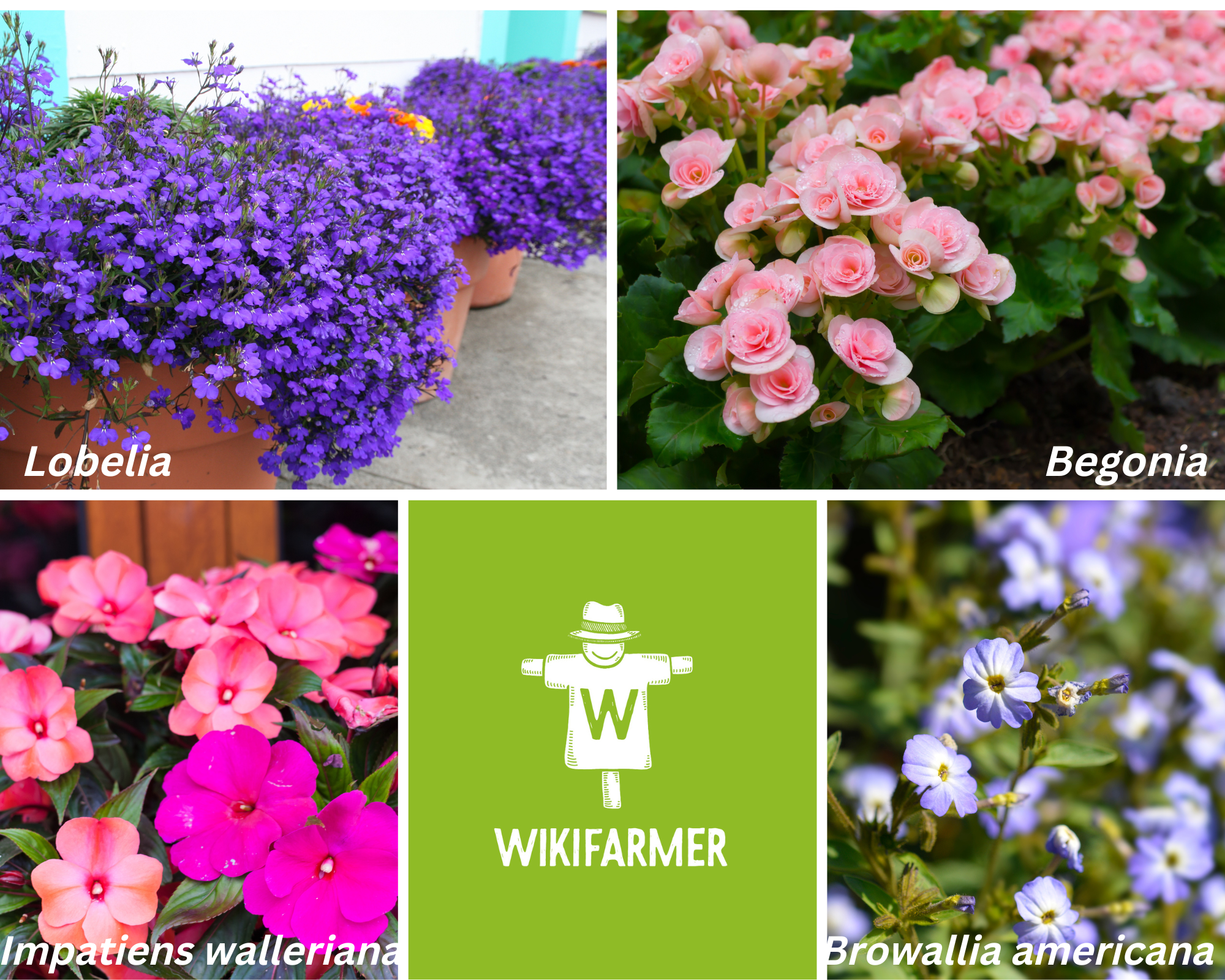
Annual flowering plants for shade
References
de la Peña, Eduardo & Schrader, Gritta & Vos, Sybren. (2019). Pest survey card on Aromia bungii. EFSA Supporting Publications. 16. 10.2903/sp.efsa.2019.EN-1731.
- https://www.rhs.org.uk/plants/for-places/shade-planting-annuals-bulbs-perennials
- https://extension.umn.edu/flowers/tuberous-begonias
- https://www.cabi.org/isc/datasheet/28769#tosummaryOfInvasiveness
- https://plants.ces.ncsu.edu/plants/impatiens-walleriana/
- https://plants.ces.ncsu.edu/plants/browallia-viscosa/
- https://www.rhs.org.uk/plants/130495/begonia-semperflorens-cultorum-group-(s)/details









































































